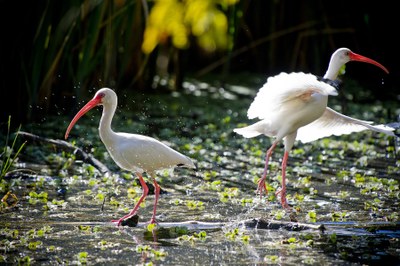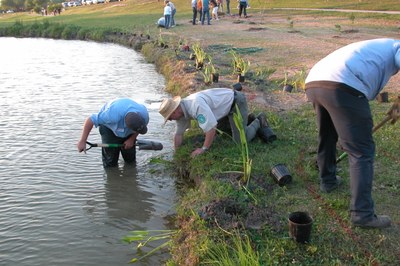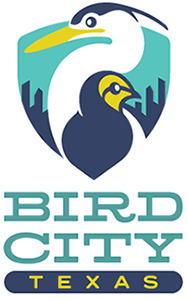FAQ

Who can apply to be a Bird City?
How long does Bird City Texas certification last? Do I have to apply every year?
What are the annual reporting requirements?
What fees are associated with the program and when do they need to be paid?
Do criteria have to be met before or after an application is submitted?
Where can I get help with the application process?
Can actions or events completed by non-governmental entities count toward meeting the criteria?
What recognition do certified communities receive?
How will managing for bird conservation and bird friendly cities have value for my community?
Who can apply to be a Bird City?
Communities of all sizes are encouraged to apply. The boundaries of the community will be defined on the Bird City Texas application. Cities, villages, towns, unincorporated areas, and multiple municipalities that operate closely together can all become Bird “Cities.” However, entities such as homeowner’s associations will not be able to fulfill the intensive criteria required to earn Bird City Texas recognition.
How long does Bird City Texas certification last? Do I have to apply every year?
Certification is issued for a three year period. At the end of the three years, communities can submit a re-certification application to maintain their Bird City status. An annual report must be submitted each year to verify that the actions planned in the community’s application were completed. Bird City status may be revoked by Program sponsors for failure to accomplish required actions, failure to maintain minimum levels of activity within a certification period, failure to submit annual reports, or anytime for major actions or policy changes that negatively and severely impact birds or bird habitat.
What are the annual reporting requirements?
All certified Bird City Texas communities must submit an annual report no later than January 31 each year that specifies the actions completed during that calendar year. The annual report is a simplified report that communicates how a community fulfilled their commitments. Communities will indicate the criteria completed in a checklist. Brief narratives and supporting materials can also be submitted to supplement the report checklist as the community and Bird City Texas team see fit.
What fees are associated with the program and when do they need to be paid?
A non-refundable $75 application fee will be required prior to submitting the application through the web portal. If your community is certified, there is a $500 fee, covering three years of certification. Payment must be submitted upon notification of certification and is due no later than March 1st after certification.
Do criteria have to be met before or after an application is submitted?
Recognition is based on what communities have already completed during the year they apply as well as their future commitments. Both are necessary for recognition and applications must reflect all four years' actions. The 18-month period from July 2021 to December 2022 will be the “year of action” on the application in 2022 for their current activities. Their planned activities should be shown for all three years of certification, showing exactly how the community will fulfill their selected actions in each category for 2023, 2024, and 2025. Once certified, communities must fulfill their commitments as outlined in their three year plan submitted with their application.
Where can I get help with the application process?
If you have specific questions regarding application submission or other basic program information, please contact us at birdcitytexas@audubon.org.
If you need assistance with developing a plan for your community to meet the requirements of the Bird City Texas program, we recommend that you consult with a professional wildlife biologist that can provide technical guidance. Texas Parks and Wildlife’s Urban Wildlife Program has biologists in 6 major urban centers and can work with your community free of charge. The U.S. Fish and Wildlife Service’s Partners for Fish and Wildlife program also has biologists stationed across Texas and can provide similar guidance to your community. In addition, private environmental consulting firms are found throughout the state and could be a good resource for technical guidance if a community has the funds available to contract the services of a wildlife biologist.
Can actions or events completed by non-governmental entities count toward meeting the criteria?
Yes! We encourage local governments to form partnerships with community organizations, schools, and local businesses to meet the Bird City Texas goals.
What recognition do certified communities receive?
Certified Bird City Texas communities will receive the following:
- "Certified Bird City" designation: For community use in promotion, application for grants, etc.
- Promotion and recognition: On Texas Parks and Wildlife and Audubon Texas websites, social media, email communication, e-newsletters, and press releases.
- Bird City Texas Community Event: A representative from Texas Parks and Wildlife Department or Audubon Texas will attend your community's Bird City Texas recognition event and will promote event through press releases and social media.
- Inclusion in State-wide Bird City Texas Workshop: To be held at least once every three years; workshops will feature panel discussions with certified communities and expert speakers highlighting urban bird conservation.
- Use of Program Logos: A digital copy of the Bird City Texas logo will be provided to all certified communities for use on their websites, publications, social media, etc.
- Bird City Texas certification materials: For display in the community.
How will managing for bird conservation and bird friendly cities have value for my community?
We can conserve land and water and have a strong economy at the same time. In fact, natural areas and the birds using them generate an economic premium. Here are some examples from recent studies of the economic data and statistics supporting the value of bird conservation to communities, local residents, and public health:
- Increase property values: Protected habitat, and the birds using it, enhances property values. Texas Tech University researchers found that the presence of birds and greenspace increased property values as much as $32,000. More bird species in an area meant higher property values. Even the presence of a single uncommon species yielded higher prices. Researchers in Massachusetts found that property located even slightly closer to a popular bird-watching spot also generated a significant property value premium.
- Annual budgetary savings: Well managed wildlife habitat provides environmental services to communities that can result in cost savings. In 2016, the Kittatinny Coalition in Pennsylvania completed a Return on Environment Study for Dauphin County, the source of water for the state capital, Harrisburg. The study showed the annual benefits for stormwater mitigation ($11.4M saved), nutrient uptake ($2.0M), groundwater recharge ($4.0M), pollination ($2.4M), erosion prevention ($0.2M), and carbon sequestration ($0.5M).
- Overall economic value: Wetlands, which provide critical habitat for waterfowl and other waterbirds, provide $3,273 per acre per year of total economic value via flood control, fishing, water treatment, biodiversity habitat nursery (including wetland dependent birds), climate regulation, hunting, water supply, raw materials, fuelwood, aesthetics, and recreation.
- Insect and rodent control: Birds control insect pests and reduce human diseases. Of the 10,000+ species of birds in the world, about 5,700 consume invertebrates. Rodents and insects carry diseases or hosts that transmit illnesses such as plague, malaria, dengue fever, and dozens of others. Insectivorous birds and raptors help keep a number of human diseases in check by consuming the rodents or insects.
- Tourism value: Recent studies show that approximately 4.4 million Texans are wildlife viewers, including 2.2 million birdwatchers, and they generate $1.8 billion dollars in economic impact for Texas.
- Value to children: Research shows that when children learn and play with nature they are healthier both mentally and physically, perform better in school, have higher self-esteem, are more cooperative with othersand more creative, make better problem solvers, have higher self-confidence, feel more connected with nature, and will be tomorrow's conservation leaders.